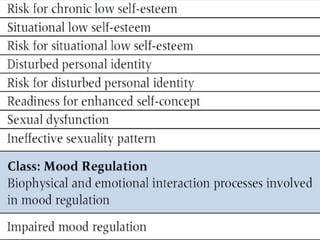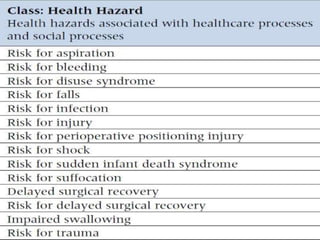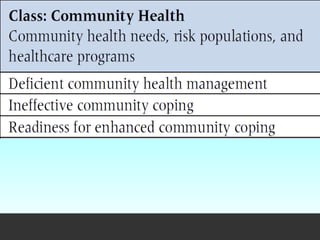Nursing process
- 2. Introduction • A process is a series of step that follow a logical sequence. The term nursing process is widely accepted to designate a series of steps that the nurse take in planning and giving nursing care • It provides a logical framework on which the nursing care is based
- 3. Definition Nursing process is a critical thinking process that professional nurses use to apply the best available evidence to caregiving and promoting human functions and responses to health and illness (American Nurses Association, 2010).
- 4. • Nursing process is a systematic method of providing care to clients. • The nursing process is a systematic method of planning and providing individualized nursing care.
- 5. Purposes of nursing process • To identify a client’s health status and actual or potential health care problems or needs. • To establish plans to meet the identified needs. • To deliver specific nursing interventions to meet those needs.
- 6. Characteristics of Nursing Process • Cyclic • Dynamic nature, • Client centeredness • Focus on problem solving and decision making • Interpersonal and collaborative style • Universal applicability • Use of critical thinking and clinical reasoning. • It is outcome oriented
- 7. Components of nursing process It involves 1. assessment (data collection), 2. nursing diagnosis, 3. Goal 4. Planning/ Intervention, 5. Rational 6. implementation, and 7. evaluation.
- 8. Nursing process 1. • assessment 2. • Nursing Diagnosis 3. • Goal 4. • Planning / intervention 5. • Rational 6. • Implementation 7. • Evaluation
- 9. ASSESSMENT
- 11. Definition Assessment is the systematic and continuous collection, organization, validation, and documentation of data (information).
- 12. Types of assessment The four different types of assessments are; 1. Initial nursing assessment 2. Problem-focused assessment 3. Emergency assessment 4. Time-lapsed reassessment
- 13. 1. Initial nursing assessment: Performed within specified time after admission. To establish a complete database for problem identification. Eg: Nursing admission assessment 2. Problem-focused assessment : To determine the status of a specific problem identified in an earlier assessment. Eg: hourly checking of vital signs of fever patient
- 14. 3. Emergency assessment: During emergency situation to identify any life threatening situation. Eg: Rapid assessment of an individual’s airway, breathing status, and circulation during a cardiac arrest. 4. Time-lapsed reassessment: Several months after initial assessment. To compare the client’s current health status with the data previously obtained.
- 15. Collection of data • Data collection is the process of gathering information about a client’s health status. It includes the health history, physical examination, results of laboratory and diagnostic tests, and material contributed by other health personnel.
- 16. Types of Data Two types: subjective data and objective data. 1. Subjective data, also referred to as symptoms or covert data, are clear only to the person affected and can be described only by that person. Itching, pain, and feelings of worry are examples of subjective data.
- 17. 2. Objective data, also referred to as signs or overt data, are detectable by an observer or can be measured or tested against an accepted standard. They can be seen, heard, felt, or smelled, and they are obtained by observation or physical examination. For example, a discoloration of the skin or a blood pressure reading is objective data.
- 18. Sources of Data Sources of data are primary or secondary. 1. Primary : It is the direct source of information. The client is the primary source of data. 2. Secondary: It is the indirect source of information. All sources other than the client are considered secondary sources. Family members, health professionals, records and reports, laboratory and diagnostic results are secondary sources.
- 19. Methods of data collection • The methods used to collect data are observation, interview and examination. Observation : It is gathering data by using the senses. Vision, Smell and Hearing are used. Interview : An interview is a planned communication or a conversation with a purpose.
- 20. • There are two approaches to interviewing: directive and nondirective. • The directive interview is highly structured and directly ask the questions. And the nurse controls the interview. • A nondirective interview, or rapport building interview and the nurse allows the client to control the interview.
- 21. STAGES OF AN INTERVIEW An interview has three major stages: 1. The opening or introduction 2. The body or development 3. The closing
- 22. Examination : The physical examination is a systematic data collection method to detect health problems. To conduct the examination, the nurse uses techniques of inspection, palpation, percussion and auscultation.
- 23. Organization of data • The nurse uses a format that organizes the assessment data systematically. This is often referred to as nursing health history or nursing assessment form.
- 24. Validation of data The information gathered during the assessment is “double-checked” or verified to confirm that it is accurate and complete.
- 25. Documentation of data To complete the assessment phase, the nurse records client data. Accurate documentation is essential and should include all data collected about the client’s health status.
- 26. DIAGNOSIS
- 28. Introduction • Diagnosis is the second phase of the nursing process. In this phase, nurses use critical thinking skills to interpret assessment data to identify client problems. • North American Nursing Diagnosis Association (NANDA) define or refine nursing diagnosis.
- 29. Definition • The official NANDA definition of a nursing diagnosis is: “a clinical judgment concerning a human response to health conditions/life processes, or a vulnerability for that response, by an individual, family, group, or community.”
- 30. Status/type of the Nursing Diagnosis The status of nursing diagnosis are actual, health promotion and risk. 1. An actual diagnosis is a client problem that is present at the time of the nursing assessment. 2. A health promotion diagnosis relates to clients’ preparedness to improve their health condition.
- 31. • A risk nursing diagnosis is a clinical judgement that a problem does not exist, but the presence of risk factors indicates that a problem may develop if adequate care is not given.
- 32. Components of a NANDA Nursing Diagnosis A nursing diagnosis has three components: (1) The problem and its definition (2) The etiology (3) The defining characteristics.
- 33. 1. The problem statement describes the client’s health problem. 2. The etiology component of a nursing diagnosis identifies causes of the health problem. 3. Defining characteristics are the cluster of signs and symptoms that indicate the presence of health problem.
- 34. Formulating Diagnostic Statements The basic three-part nursing diagnosis statement is called the PES format and includes the following: 1.Problem (P): statement of the client’s health problem (NANDA label) 2. Etiology (E): causes of the health problem 3.Signs and symptoms (S): defining characteristics manifested by the client.
- 35. Acute pain related to abdominal surgery as evidenced by patient discomfort and pain scale. Problem Etiology Signs and symptoms Pain Surgery of abdomen Pain scale and discomfort of patient
- 64. Differentiating Nursing Diagnosis from Medical Diagnosis Nursing diagnosis Medical diagnosis A nursing diagnosis is a statement of nursing judgment that made by nurse, by their education, experience, and expertise, are licensed to treat. A medical diagnosis is made by a physician. Nursing diagnoses describe the human response to an illness or a health problem. Medical diagnoses refer to disease processes. Nursing diagnoses may change as the client’s responses change. A client’s medical diagnosis remains the same for as long as the disease is present.
- 65. Nursing diagnosis Medical diagnosis Ineffective breathing pattern Asthma Activity intolerance Cerebrovascular accident Acute pain Appendicitis Disturbed body image Amputation
- 66. PLANNING
- 68. • Planning involves decision making and problem solving. • It is the process of formulating client goals and designing the nursing interventions required to prevent, reduce, or eliminate the client’s health problems.
- 69. TYPES OF PLANNING 1. Initial Planning 2. Ongoing Planning 3. Discharge Planning
- 70. 1. Initial Planning : Planning which is done after the initial assessment. 2. Ongoing Planning : It is a continuous planning. 3. Discharge Planning : Planning for needs after discharge
- 71. Planning process Planning includes; • Setting priorities • Establishing client goals/desired outcomes • Selecting nursing interventions and activities • Writing individualized nursing interventions on care plans.
- 72. Setting priorities • The nurse begin planning by deciding which nursing diagnosis requires attention first, which second, and so on. • Nurses frequently use Maslow’s hierarchy of needs when setting priorities.
- 74. Establishing client goals/desired outcomes • After establishing priorities, the nurse set goals for each nursing diagnosis. Goals may be short term or long term.
- 75. Nursing interventions • A nursing intervention is any treatment, that a nurse performs to improve patient’s health.
- 76. TYPES OF NURSING INTERVENTIONS 1. Independent interventions are those activities that nurses are licensed to initiate on the basis of their knowledge and skills. 2. Dependent interventions are activities carried out under the orders or supervision of a licensed physician. 3. Collaborative interventions are actions the nurse carries out in collaboration with other health team members
- 77. Writing Individualized Nursing Interventions • After choosing the appropriate nursing interventions, the nurse writes them on the care plan. • Nursing care plan is a written or computerized information about the client’s care.
- 78. IMPLEMENTATION
- 79. • Implementation consists of doing and documenting the activities.
- 80. The process of implementation includes; • Implementing the nursing interventions • Documenting nursing activities
- 81. EVALUATION
- 82. • Evaluation is a planned, ongoing, purposeful activity in which the nurse determines (a)the client’s progress toward achievement of goals/outcomes and (b)the effectiveness of the nursing care plan.
- 83. The evaluation includes; • Comparing the data with desired outcomes • Continuing, modifying, or terminating the nursing care plan.




















































































